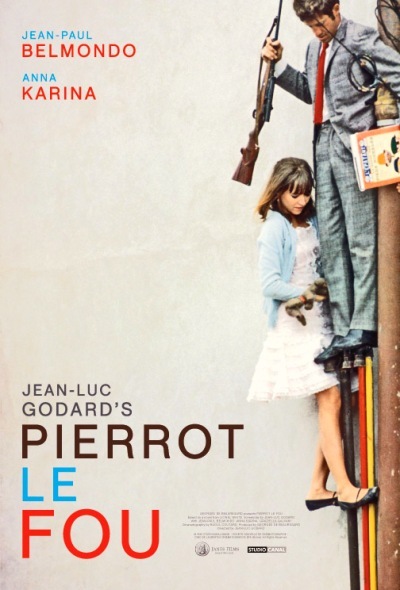- Pierrot le fou
Infobox Film
name = Pierrot le fou

writer =Jean-Luc Godard
starring =Jean-Paul Belmondo Anna Karina
director =Jean-Luc Godard
distributor =
released =November 5 1965 (France)
runtime = 110 min.
language = English/French | amg_id = 1:38120
imdb_id = 0059592
budget ="Pierrot le fou" is a
1965 film directed byJean-Luc Godard , starringAnna Karina andJean-Paul Belmondo . The film is based on "Obsession", a novel byLionel White . It wasJean-Luc Godard 's tenth feature movie, released between "Alphaville " and "Masculin, féminin ".Plot
Ferdinand Griffon (
Jean-Paul Belmondo ) is unhappily married and has been recently fired from his job at a TV broadcasting company. After a boring party inParis , he decides to leave his wife and children for his baby-sitter, an ex-girlfriend, Marianne Renoir (Anna Karina ). Following her into her apartment and finding a corpse, Ferdinand soon discovers that Marianne is being chased byAlgeria n gangsters, two of whom they barely escape. Ferdinand (whom Marianne decides to callPierrot , much to his annoyance) and Marianne go on a traveling crime spree fromParis to theMediterranean Sea in the dead man's car. They lead an unorthodox life, always on the run. Settling down in theFrench riviera after having burnt the dead man's car (full of money) and sunk a second car into theMediterranean Sea , their relationship gets worse and worse. Ferdinand does not understand nor wish to understand the adventure into which Marianne brought him and ends up reading books, philosophizing and writing in his diary. Marianne becomes bored by Ferdinand's settled life and drives him into a night-club where they meet one of their pursuers. After defeating the gangsters, Marianne and Ferdinand are separated, with Marianne traveling in search of Ferdinand and Ferdinand settling inNice . After their eventual reunion, Marianne uses Ferdinand to get a suitcase full of money that was taken from the gangsters before running away with her real boyfriend, to whom she had previously referred as her brother. Pierrot shoots Marianne and her boyfriend, and, in the climactic scene, paints his face blue and decides to blow himself up by tying sticks of red and yellow dynamite to his head. Regretting his decision at the last second, he tries to extinguish the fuse, but he is blinded by the dynamite and is blown up.Themes and style
"Pierrot le fou" is shot in vivid colour, with numerous objects and clothes being in bright
primary colours . Like many of Godard's films, it features characters who break thefourth wall by looking into the camera. It also includes startling editing choices; for example, when Pierrot throws a cake at a woman in the party scene, Godard cuts to an exploding firework just as it hits her. The film has many of the characteristics of the then dominantpop art movement, [http://books.google.com/books?id=BY6vxfbcglsC&pg=PA12&dq=%22pierrot+le+fou%22+%22pop+art&as_brr=0&sig=ACfU3U2E2IUtplnpIzO7EafO5aEJuFeklg] making constant disjunctive references to various elements ofmass culture . Like much pop art the film uses visuals drawn from cartoons and employs an intentionally garish visual aesthetic based on bright primary colors such as red, blue, and yellow."Pierrot le fou" is sometimes seen as an early and
paradigm atic example ofpostmodernism in film. [http://books.google.com/books?q=%22a+postmodern+film+before+postmodernism+was+invented&as%5fbrr=0] The film's postmodern elements include its parodic but affectionate attitude towards American pop culture, its deliberate mixing of high and low art, its frequent dissection of popular movie conventions, and its use of a decentered, collage-like (orparatactic ) narrative structure. The central character of Ferdinand also embodies Jameson's notion of the postmodern citizen as a victim of "compensatory decorative exhilaration" or a mass media-addled mindset in which individuals lose the ability to distinguish truth from fiction or important issues from trivial ones.Fact|date=March 2008The film's episodic structure provides Godard with the opportunity to express many conflicted feelings about
pop culture ,politics , America,literature ,music , and cinema itself. Like many of Godard's films, "Pierrot" focuses on the conflicts that arise from lack of communication between men and women. It also makes numerous references to theVietnam war and theAlgerian war . For example, Marianne and Pierrot entertain American tourists on a beach, miming war scenes in which Pierrot is a US soldier and Marianne a Vietnamese girl, referred to as "Uncle Sam's Nephew" and "Uncle Ho's Niece". Ferdinand is also tortured by being waterboarded in a bathtub, a technique often used by the French during theAlgerian war . (A similar, though more prolonged, torture session occurs in Godard's 1960 film, "Le Petit Soldat ", where the perpetrators are agents of the anti-French FLN.)Production
Sylvie Vartan was Godard's first choice for the role of Marianne but her agent refused. [ [http://www.humanite.presse.fr/journal/1994-11-09/1994-11-09-711754 Interview with Sylvie Vartan (in French)] ] [http://assets.cambridge.org/97805215/73757/sample/9780521573757wsn01.pdf Jean-Luc Godard's Pierrot le fou] ed. David Wills, Cambridge University Press, 2000 (first 20 pages)] Godard consideredRichard Burton to play the role of Ferdinand but gave up the idea.As with many of Godard's movies, no scenario was written until the day before shooting (at best), and many scenes were improvised by the actors, especially in the final acts of the movie. The shooting took place over two months, starting in the
French riviera and finishing in Paris (in reverse order from the edited movie).Jean-Pierre Léaud was an uncredited assistant director on the movie (and also appears briefly in one scene).The American film director in the party scene is portrayed by
Sam Fuller .Influence
*
Mathieu Kassovitz 's first short movie is called "Fierrot le pou" ("Fierrot the louse").
* The twentieth episode of "Cowboy Bebop " is entitled "Pierrot le Fou."External links
*
* [http://seul-le-cinema.blogspot.com/2008/05/528-pierrot-le-fou.html Review by Ed Howard at Only The Cinema]Notes
Wikimedia Foundation. 2010.
